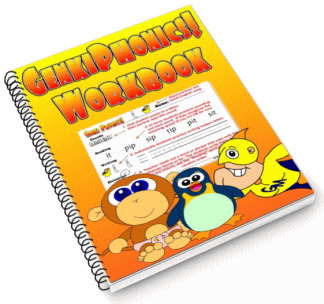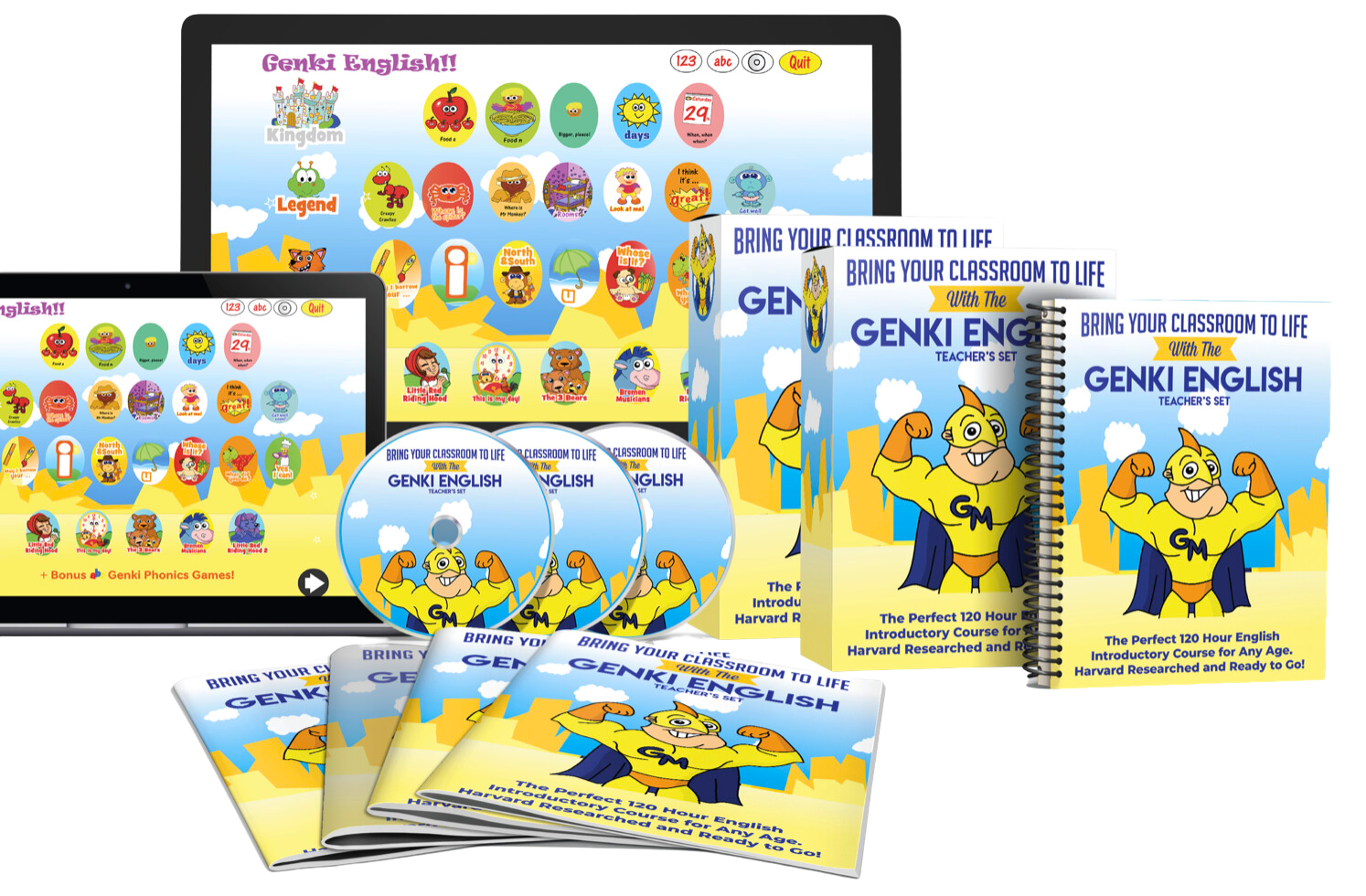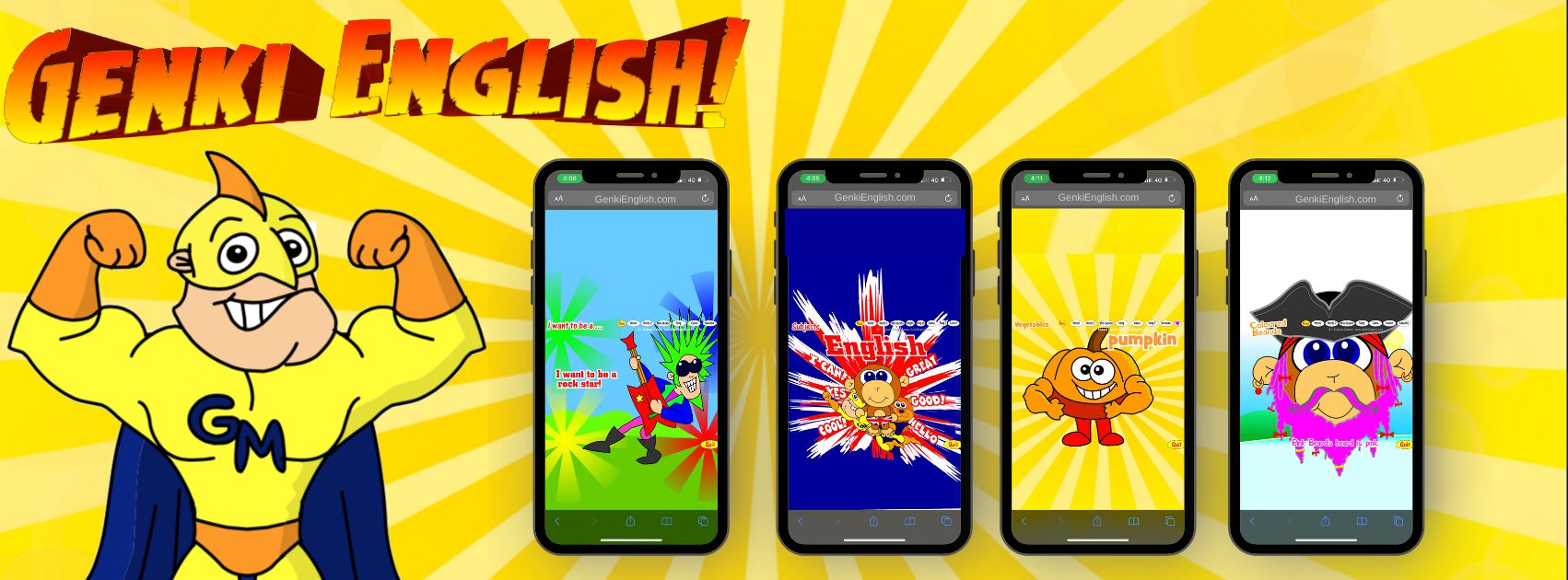Update: The Phonics Workbook is now finished and you can find it on the main Genki Phonics page – enjoy!
A few of you know I’ve been working on a completely new integrated phonics system, so once your students can speak and listen with the main Genki English curriculum it’s really easy to teach them to read.

The programme is still going to take quite a while to finish, but the first part of the workbook is just about ready. So in the spirit of “it’s better out there than stuck on my hard drive” I’ve made it ready for you to download!
Update: The Phonics Workbook is now finished and you can find it on the main Genki Phonics page – enjoy!
To get the most out of it you really need to follow a good phonics lesson plan (like on the forum), but even without that it’s better than 99.9% of the other phonics worksheets / workbooks out there on the internet!
What do you think?




WOW, WOW and WOW! I love it! Great stuff! This is just what I needed and I can’t wait to use it!
I really almost hate to ask this, but would it be possible to have it in a different font? I am guessing that you chose this type of writing because it is easier for small children to write, but if my students wrote like this on a test in my Japanese junior highs, they would be marked WRONG. (please don’t let me get started on how I feel about this…I had to mark a lot of students wrong for writing words like Wednesday if they didn’t write the capital letter like 2 Vs as opposed to one “small mountain” in the middle.
Glad you like it. It might be possible to do a different font in the future. But the font used here is the Sassoon Primary font, which is generally agreed to be one of the best fonts to use with writing. It would be very difficult to come up with another font that is as good!
YEAHHHHHH! Thank you! This looks so beautiful on first sight. The kids will love it. I think I’m going to print out the first page (orange cover) on hard paper.
I wanted to continue phonics after having had a long break. But it ended up in a few tears, so I stopped right away and decided to wait until I can do them in a intensive course during holidays, or till this one comes out.
Wow now I can start cause I can see how they will love it and how it won’t take too much time of a lesson to do one page.
I really like this font. Though what gumby says makes me worry. I can’t believe that a different writing would be marked as mistakes. How horrible. I would love to teach my kids cursive writing, and they really want to learn it, so we are doing at least their names. This font I think is a good alternative.
I can’t wait to print it out.
Outtasight! Great stuff. And perfect timing as I’m introducing phonics to one of my afternoon groups when school returns next week.
Being totally incompetent I couldn’t find the lesson plan referred to in your post. Any other definite clues as to where to find it on the forum? Thanks.
hey! this is great man! it’s colourful, fun and packed! i hope u dont mind me trying it on the kids. will give u feedback. insyaAllah.
Not had a chance to look at this properly yet, but, man, I’ve been waiting long enough! It’s just bound to be good – it has that Genki seal of approval!
I’m still shocked at gumby having to mark kids wrong for writing normally…..
Part way down this page: http://genkienglish.net/clipart/forum/viewtopic.php?t=676&postdays=0&postorder=asc&start=30
You can’t imagine what great timing you have!! One of my adult students just asked me to do phonics with her and this is just great for using it with her! Perfect!! Thanks a million 🙂
Yeah, it was not fun. I didn’t have much say because the students were repeatedly told to watch their letters, particularly (W,M,I,K)before the test. When I helped for the beginning English class I had to use white-out on all the capital K’s because the handouts I had did not have the ‘correct’ writing.
Students in my school learn written English ‘officially’ in junior high and spend a lot of time on penmanship.
Of course this doesn’t mean that all teachers need to follow these rules. Some rules were made to be broken. However if these rules are the norm, it’s something elementary teachers need to consider.
Great. Thank you.
I’m so thrilled it’s FINALLY here!! I have been waiting!!! It’s really super. I love the format, the colors, the words chosen.
A question: why aren’t there more pictures for “i” like pig or pink or fish? I know you aren’t finished but the first pages seem done except this one.
Anyway, it looks fabulous!! 🙂 Thank you.
Thank you for your hard work. I printed off the first few pages and gave them to my 6 year old son who has learnt jolly phonics at primary school. He immediately took my 4 year old daughter off and started teaching her to read and write, so you have definitely succeeded in making it child friendly – I didn’t tell him how it worked and he was using it perfectly! I like the clear lay out. Shame my english class is too young for it.
I kept the keywords to only the initial sound. That way it’s easy to remember, you see the SSSSuperhero and it has to be “s”. “Pig” I can’t use in many countries anyway!
Cool.
Wow! Thank you, Richard!
I have never learnt phonics systematically by myself, but by reading the instructions you wrote in red on page 2, I think I understand how to use this course. I like the way you add one sound each time.
Really great!
I’ve seen through the pages and it’s like seeing Genki English from all angles. Very interesting!
As to the font, I have never had problems like what gumby said. (I used to be a JHS teacher.) I don’t know, but maybe it depends on what kind of letters are required in entrance exam of senior high school in the area?? My daughter will enter JHS this April, then I will know the answer.
Thanks for these. I started straight away with “S” last night in one of my classes, and it went down pretty well. Once we’ve worked though the first few, I think we’ll be able to do a lot with them!
Richard,
NOW I think it would be great to have the phonics cD.
Do you have any plans to make one in the sequence of the letters appearing in this book?
I just printed out the whole book for 6 students. It looks so beautiful. I’m starting tomorrow. My daughter can’t wait.
RE: Phonics CD. This is what I was planning to do with my studio time in the UK over Xmas! Needless to say it didn’t get done!
Instead what I plan on doing is just using the normal GE songs with the vocab from the book. Then for graphemes that don’t have much (e.g. “o”) I’ve got a couple of new songs, for example the “i” song I did last year.
Plus I also intend to finish the Phonics & Funk songs, as long as my eyes keep getting better!
This looks fantastic…
You know what would be awesome? If you could add phonemic characters!!!
That would help us teachers pick them up AND really really help the kids with their dictionary work!
great looking book Richard, won`t get the chance to use it myself (leaving shortly) but I have passed it to my Home Room Teacher who was very pleased.
Wow…I used to hate phonics, but I’m beggining to understand phonics and how it works.
Your explanations and illustrations are quite clear! I just LOVE the work sheets!!!
Thanks Richard!
Nena
Hi Jonathan, thanks for the reply. One of the coolest things about phonics is that you don’t need to teach any other phonetic characters at all. The kids go straight from speaking to reading, just like magic!
This book is really something!!!When I began to look through it, I just had a feeling, that I’m in a Fairy Land, that all those letters, animals, fruit could speak!!! I felt myself like a happy kid willing to study, though I’m a teacher already))) Richard, such books are like a key to a child’s heart? it’s a great way to make learning interesting and fun!!!)) Thanks
I have added a comment on the forum, but just wanted to say here too a BIG THANK YOU RICHARD!!! The workbook looks great and I imagine the end programme will be excellent!! Great job!!
Really appreciate this! I’ve been really frustrated trying to teach this younger student of mine how to read (i am also a student)so great job! I’m looking forward to teaching with this material! thank you so much!
Awesome book. This is perfect for one of my classes. I recently got the download pack (great purchase!!!), and was just wondering what is the best way to make this into book form apart from just printing off. Richard, if you are listening, I would love to know what you do for the printed versions. Do you ring bind them or something? Margit mentioned using hard paper for the first piece. I would just like to present these phonics in book form in as nice a way as possible. You know, laminated flashcards look twice as good as just printed out flashcards!!! And of course color is optimal. Any tips would be greatly appreciated.
Hi Stephen,
Very good question actually!
First of all, there is the new version if you fancy tackling the stories ASAP ( we’ll help you out in the forum!)
http://genkienglish.net/teaching/help-please-genki-phonics-2-proof-reading-osaka-workshop-nov-18th
Then it is usually best to do give them out ONE SHEET AT A TIME.
If you give them in a book then very often the parents grab hold of the future ones, tell the kids how to “read” and memorise them!
So it’s better if you can to do one as you teach it and then put it in a ring binder or folder.
Doesn’t look quite as good, but tends to work better!
Does that help?
Exactly the information I was after!!! Thanks as always. Yeah, now that you mention it, I am using an alphabet book in one of my classes and he is doing exactly what you said in class- prereading ahead. If only I had downloaded your pack a bit earlier. Might have to collect the books after every class instead!!! Now all I need to do is find a nice file to put all the worksheets into!!!
Oh, thanks for the latest link fit the phonics book as well. I’d like to know why you changed the order of letters in the book!
I talk about it in the video:
http://genkienglish.net/teaching/help-please-genki-phonics-2-proof-reading-osaka-workshop-nov-18th
100 yen store is the best place for great folders!
One other tip, if you don’t have desks, is to give the kids one of the bright orange clip boards you can get at the hundred yen store. The kids clip the new sheet on there, they’re sturdy for reading from and are fun coloured, then they put them in their folder when (or just before) they go home!
Well, once again you have provided me with all the answers!!! Cheers!!!
Hi Stephen,
I do print the book in 3-4 parts (around 20 pages each).
I agree with Richard, though, that the parents (or kids themselves) need to be told NOT TO do anything at home, that they are not told to do.
So, if you have the control over this, and the possibility to communicate straight with the parents~for me this works.
With the single pages the thing is that kids can just be so messy and putting one single page into the folder takes at least 5, with 1st graders up to 10 minutes of class.
Also copying every week is something I don’t like so much.
Also financially it is easier for me to hand out a workbook, as I hate to take money for 1 page I hand out. I used to gather a certain amount once a year for copies but it is too “about”.
With the workbooks I can get the amount it took me and no one complains.
BTW: You can get nice binding tape also at Daiso.
And maybe this thread helps you as well:
http://genkienglish.net/teaching/evaluation-imagination-worksheets-cd12-workbook
Thanks for the advice Margit!!! It would be great to have a how to make your downloaded books cool section, you know, like actual pictures and stuff. Yeah,I understand about the collection of money thing. I was going to do what Richard suggested, but know I’m lost. I’m thinking off maybe printing everything and making a book, but have the students hand in their books each time and leave them in the classroom….I would also like to know what you mean exactly by binding tape. Thanks for taking the time to write these mails to me! I’ll check out that vid tonight!!!
Yeah, the naming of the tape is probably not the best; I can’T find the actual name though:
It’s kind of a double sided duct tape. You can get it in roles,(bit expensive) at Daiso they have it in stripes a bit longer than actually needed for the GE phonics workbook.
So, what I do is I staple the pages together with a normal stapler and than I cover the “stapler needles” (that can be dangerous and for sure don’T look so cool) with that tape.
I like your idea of keeping the workbooks in the classroom. This way the parents will be even more surprised when their kids suddenly come home and can read, though they haven’t had any workbook in there shelf at all.
And I mean, this really IS the best of this course: No stress with reading and writing for homework, just sun 10 minutes a week in class and the kids get a high proficiency in reading.
Hey guys, I was ready to print out the new book and stuff, but I am interested in why you chose that font that you did Richard. For example, why did you chose that font for the letter k. Everything about the phonics book is awesome, but some of the fonts for some of the letters are not that standard. I would love to hear why because I really want to print out those books, but just want to make sure, after all, its 98 pages!!!
Hi Stephen, it uses the Sassoon font, it’s designed to be the best bridge between handwritten and modern printed forms and has now pretty much become the standard font for primary school in most English speaking countries!
Hey Margit and Richard, thanks for your comments. They are, as always, very helpful. Wow, I am not really that familiar with the Sasson font. Maybe I have to study that phonics book as well to learn how to write again!!! I guess my one concern about teaching the Sasson font is that if these kids write these letters in their English class in Japan, they would probably be marked as being incorrect, as Gumby wrote about in his comments. Not that I can talk, I probably would have as well!!! But now that you mention it, some young children’s English books I purchased recently from Australia were using the Sasson font. I guess I have to get with the times.
But I can use this as a selling point as well. For example, my school uses the Genki English Phonics workbook, which teaches how to write letters that are currently taught to native speakers but are not taught in Japanese schools!!! Nice one!!!
Thanks guys, I always feel like I learn something new each time I write a comment!!! Much appreciated!
@Stephen:
as for “k” I tell them the “common” taught one as well and write it next to the one in the book. Not because it is too different but because they mix it up with the capital “R”. I DO NOT teach capitals, but they know them anyway, and it seems confusing for them.
Anyway, then I give the kids the option to write it this way or the other, and they do really fine with it.
Have a nice printing!
Sorry for the twenty questions, but what is the best way to print out these books? Do you use your own printer, or ask a printing company to do it? Margit, you also mentioned charging for the books and dividing them up into three sections. I would love to hear how you divide them.
Stephen, I’ll pm you from the Forum!